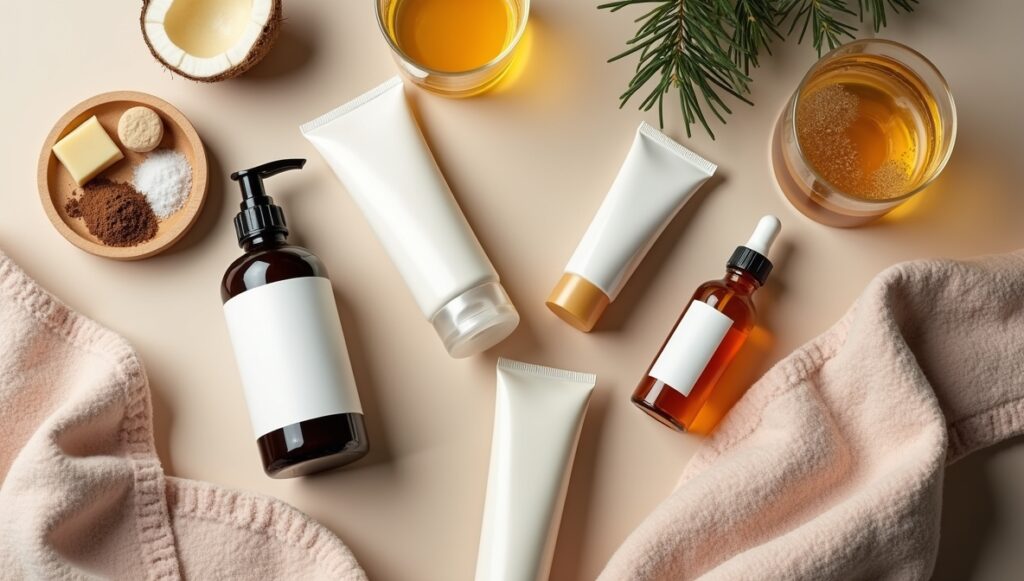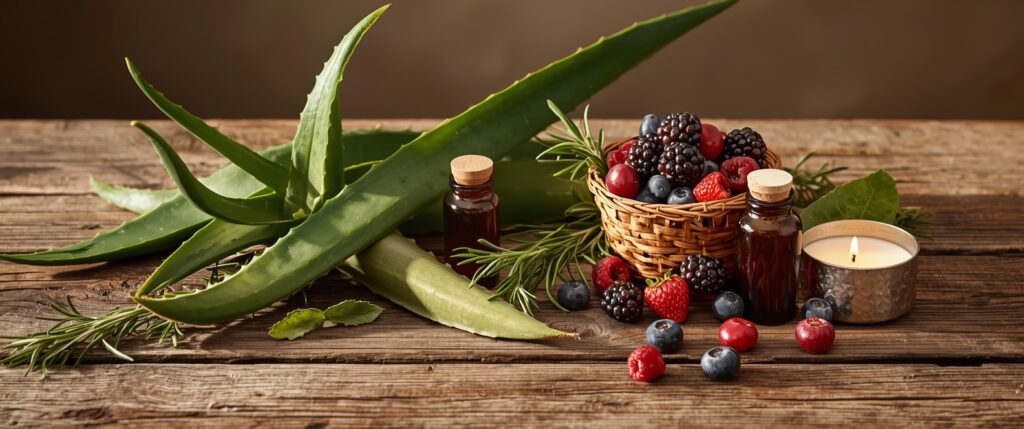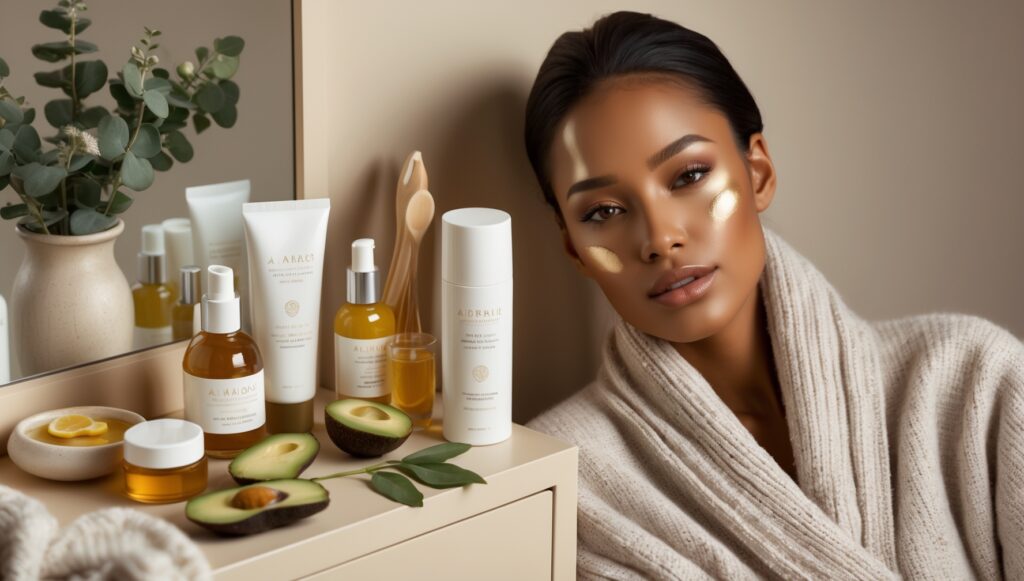
The Season That Tests Your Skin
Winter is the season of contrasts — cozy sweaters, hot drinks, and crisp air, but also tight, flaky, and dehydrated skin. As temperatures drop, humidity levels plummet, stripping the skin of its natural moisture. At the same time, indoor heating pulls even more hydration from the air, leaving the skin barrier stressed, dull, and prone to irritation.
While summer skincare focuses on protection from sun and sweat, winter demands nourishment, repair, and balance. The goal is not just to prevent dryness but to train your skin to retain moisture and resilience despite environmental stress.
Your skin is a living barrier — and winter is its ultimate test. Understanding how it reacts to cold, dry conditions is the first step toward maintaining that healthy, dewy glow all season long.
Understanding Winter Skin: The Science Behind the Dryness
Low Humidity Means Less Moisture Retention
Cold air can’t hold much water vapor, which means less atmospheric moisture for your skin to absorb. Without this environmental support, even well-hydrated skin begins to lose water to the air — a process called transepidermal water loss (TEWL).
Temperature Swings Weaken the Barrier
Moving between cold outdoor air and overheated indoor spaces shocks the skin. These rapid shifts cause capillaries to contract and expand, leading to redness, sensitivity, and sometimes broken vessels.
Sebum Production Drops
In cold weather, oil glands become less active. While that sounds great for oily skin, it often results in an unbalanced barrier — one that lacks the lipids needed to seal in hydration.
Barrier Damage Leads to Sensitivity
A compromised skin barrier doesn’t just feel dry — it becomes reactive. Redness, flakiness, and rough texture are signs that your protective layer is struggling.
Winter doesn’t just dry your skin; it alters its physiology. Your skincare routine, therefore, must adapt — focusing less on “cleansing and correcting” and more on strengthening, layering, and sealing.

The Science of Hydration: More Than Just Moisture
When people think “hydration,” they often picture applying a thick cream or drinking more water. While both help, real hydration happens through balance — between water, lipids, and a functioning skin barrier.
Here’s how it works:
- The epidermis (outermost skin layer) contains a natural moisturizing factor (NMF) made up of amino acids, urea, and lactic acid. These attract and hold water.
- The lipid barrier — built from ceramides, cholesterol, and fatty acids — locks that water in.
- When either layer is compromised, moisture escapes, no matter how many serums you use.
Winter’s dry air accelerates water loss, while indoor heating depletes lipids. That’s why the key to glowing winter skin isn’t just hydration — it’s hydration + barrier repair.
So, your routine needs to layer products that draw in moisture, trap it, and protect it.
Building the Perfect Winter Skincare Routine
A professional, winter-ready routine doesn’t have to be complicated — it just needs to be strategic. Think of it as a layering system for your skin, like dressing for the cold: base, insulation, and protection.
Morning Routine: Protect and Prevent
- Gentle Cleanser: Choose a mild, low-foaming cleanser that doesn’t strip natural oils. Avoid gels and opt for cream or balm cleansers that leave the skin supple.
- Hydrating Toner or Essence: Apply a lightweight toner rich in humectants like glycerin or hyaluronic acid to attract water into the skin. Think of it as the foundation of your hydration stack.
- Serum: Go for a hydrating or barrier-strengthening serum. Look for niacinamide, panthenol, or beta-glucan — ingredients that soothe and repair.
- Moisturizer: Your winter moisturizer should be slightly thicker than your summer one. A formula containing ceramides, squalane, or shea butter seals in the serum’s hydration while rebuilding the lipid barrier.
- Sunscreen (Yes, Even in Winter!): UV rays penetrate clouds and reflect off snow. A broad-spectrum SPF 30+ is essential to prevent photoaging and barrier damage. Choose a hydrating formula that doubles as a protective layer.
Evening Routine: Repair and Replenish
- Double Cleanse (Optional): If you wear makeup or sunscreen, start with an oil-based cleanser followed by your cream cleanser. This ensures you remove impurities without stripping the skin.
- Hydrating Layers: After cleansing, use a hydrating mist or essence immediately while the skin is damp. Follow with your serum and moisturizer to lock in the moisture.
- Night Cream or Sleeping Mask: A richer night cream or an overnight sleeping mask adds an occlusive layer, trapping hydration and allowing deeper repair overnight.
- Eye Cream or Oil (Optional): Winter can emphasize fine lines due to dryness. A peptide-rich or oil-based eye cream can prevent dehydration in the delicate under-eye area.
Weekly Additions
- Gentle Exfoliation (1–2 times/week): Use mild lactic acid or PHA exfoliants to remove dry flakes and help products penetrate better.
- Hydrating Mask (1–2 times/week): A sheet or gel mask with aloe vera, panthenol, or honey can provide a quick moisture boost.
Pro Tip: Apply skincare to slightly damp skin — it traps water molecules better. And always finish your routine with the richest product last to seal everything in.
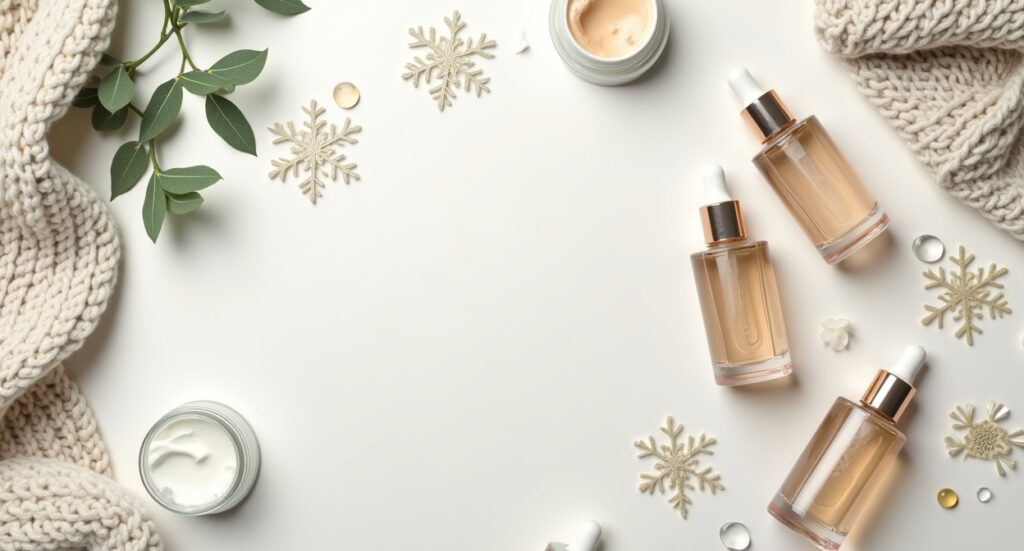
Ingredients That Save You: The Winter Skin Saviors
The right ingredients can transform your skin’s behavior in cold weather. Instead of fighting dryness with random thick creams, it’s smarter to use layered, science-backed ingredients that replenish both water and lipids while soothing inflammation.
Here’s your essential ingredient guide for winter skincare:
1. Ceramides — The Barrier Builders
Ceramides are like the bricks of your skin barrier. They make up nearly half of the skin’s outer layer and are vital for keeping moisture locked in.
Why you need them: Winter depletes ceramide levels, making your skin more vulnerable.
Best for: All skin types — especially dry, sensitive, or mature skin.
Pro tip: Look for moisturizers that list ceramide NP, AP, or EOP in the ingredients.
2. Hyaluronic Acid — The Moisture Magnet
This humectant holds up to 1,000 times its weight in water and helps keep the skin plump and hydrated.
Why you need it: Indoor heating and cold air dehydrate your skin’s surface.
How to use it right: Always apply on damp skin, then seal it with a moisturizer — otherwise, it can draw moisture out of your skin if the air is too dry.
3. Squalane — The Lightweight Oil Your Skin Loves
Squalane mimics the skin’s natural sebum, helping restore lipid balance without feeling greasy.
Why you need it: It strengthens the barrier, locks in hydration, and suits even acne-prone skin.
Bonus: It’s non-comedogenic, meaning it won’t clog pores.
4. Glycerin — The Classic Humectant
A timeless skincare hero that pulls water from both the air and deeper skin layers to hydrate the surface.
Why you need it: It works in tandem with ceramides and emollients, making it perfect for multi-layer hydration routines.
5. Niacinamide — The Barrier Multitasker
Niacinamide (Vitamin B3) is one of the most versatile winter ingredients.
Benefits: Strengthens the skin barrier, reduces redness, balances oil, and improves elasticity.
Concentration tip: 5% or less is ideal for daily use in winter to avoid irritation.
6. Fatty Acids & Natural Oils — The Nourishing Layer
Think jojoba, rosehip, argan, or meadowfoam seed oil. These oils mimic the natural lipids your skin produces.
Why you need them: They replenish oils lost to harsh weather and form a soft, breathable seal over your skin.
Pro tip: Apply a few drops as the last step of your nighttime routine.
What to Avoid in Winter: Common Skincare Mistakes
Not everything that’s good in summer works in winter. Here are the top things to cut back or adjust:
1. Over-Exfoliating
While exfoliation helps remove dead skin cells, doing it too often strips the barrier and causes micro-cracks.
Tip: Limit chemical exfoliants to once or twice a week, and avoid scrubs with harsh particles.
2. Alcohol-Heavy Toners
Astringent or alcohol-based toners (often labeled as “oil-control”) can dehydrate your skin further.
Alternative: Use toners rich in humectants or soothing extracts like green tea or centella asiatica.
3. Hot Showers & Over-Cleansing
Hot water feels heavenly in winter but melts away protective oils. Similarly, washing your face too often strips its natural balance.
Tip: Use lukewarm water and a gentle cleanser. Pat dry — never rub.
4. Retinoid Overuse
Retinoids are powerful, but in dry seasons, they can trigger redness or flaking.
Tip: Buffer them with moisturizer (“sandwich method”) or use them every other night.
5. Fragrance-Heavy Products
Artificial fragrance can irritate dry or sensitized skin in winter.
Tip: Opt for fragrance-free or naturally scented products with essential oils in low concentrations.
Winter skincare isn’t about doing more — it’s about doing smarter. Using the right mix of humectants, emollients, and occlusives ensures your skin stays hydrated, supple, and calm even when temperatures drop.
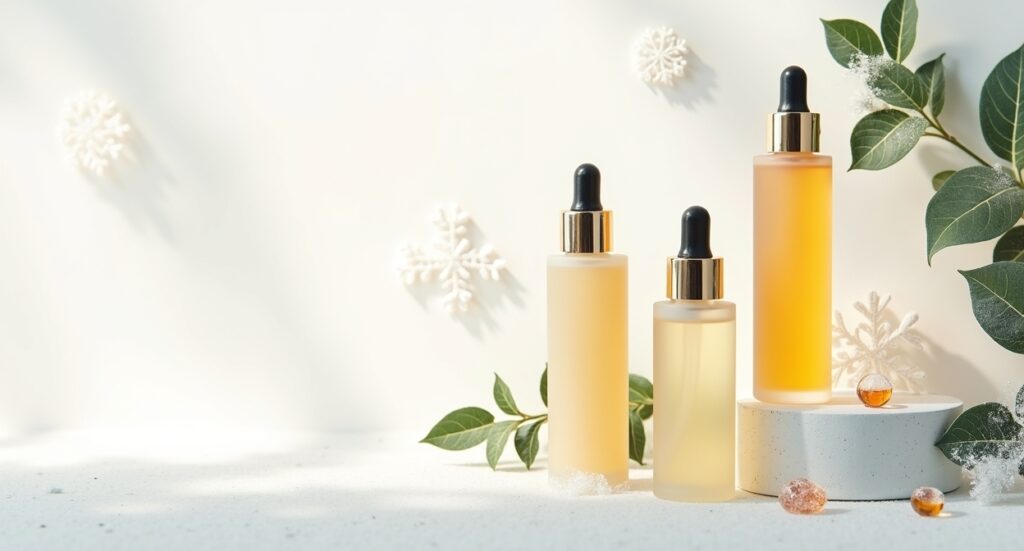
Lifestyle Adjustments: Beauty Starts Beneath the Surface
Healthy winter skin isn’t only made at your vanity — it’s also built in your kitchen, bedroom, and daily routine. Here’s how to support your skin from the inside out.
1. Hydrate Smartly (It’s More Than Just Drinking Water)
Yes, hydration starts with water intake — but in winter, you often feel less thirsty, leading to dehydration without realizing it.
- Aim for consistency: Sip water steadily throughout the day rather than chugging large amounts occasionally.
- Upgrade your hydration: Herbal teas (like chamomile or green tea) and water-rich foods (cucumbers, oranges, soups) add subtle moisture.
- Avoid dehydrators: Limit caffeine and alcohol, which can dry your skin from within.
2. Feed Your Skin with Nutrients
Your skin reflects your diet. To fight dryness, you need foods rich in healthy fats, antioxidants, and vitamins.
- Omega-3 fatty acids: Found in salmon, chia seeds, and walnuts — these strengthen the lipid barrier.
- Vitamin E: Protects against oxidative damage; get it from almonds, spinach, and avocado.
- Vitamin C: Boosts collagen and helps your skin recover from environmental stress; oranges, kiwis, and bell peppers are great options.
- Zinc: Essential for repair and inflammation control; found in lentils, pumpkin seeds, and seafood.
3. Sleep: Your Overnight Skin Therapy
Sleep isn’t just rest — it’s repair. During deep sleep, your skin’s blood flow increases, allowing regeneration and collagen production.
- Aim for: 7–8 hours each night.
- Pro tip: Use a silk pillowcase to reduce friction and prevent moisture loss overnight.
4. The Power of Humidity Indoors
Heaters make your home cozy but brutally dry.
- Use a humidifier: Aim for indoor humidity levels of 40–50%.
- Alternative: Place bowls of water near heating vents — they’ll naturally evaporate moisture into the air.
- Why it matters: Balanced humidity prevents your skin from losing water and keeps your barrier happy.
5. Stress & Skin Connection
Winter can be emotionally draining — shorter days, less sun, more indoor time. Chronic stress raises cortisol, which weakens your skin barrier and slows healing.
Tip: Integrate small rituals — stretching, journaling, aromatherapy, or even a nightly face massage. Your mind relaxes, and your skin follows.
DIY Winter Skincare Treatments: Gentle, Nourishing, and Effective
Homemade masks and treatments can be a soothing part of your winter ritual — as long as they’re gentle and barrier-friendly. Here are a few dermatologist-approved DIY ideas:
1. Hydrating Honey-Oat Mask
Ingredients: 1 tbsp honey + 1 tbsp ground oats + a splash of milk or yogurt.
Benefits: Honey draws moisture, oats soothe irritation, and milk adds gentle lactic acid for mild exfoliation.
How to use: Apply for 15 minutes, rinse with lukewarm water, and follow with moisturizer.
2. Aloe-Cucumber Cooling Gel
Ingredients: 2 tbsp aloe vera gel + 1 tbsp cucumber juice.
Benefits: Reduces redness, hydrates, and calms inflammation — great after exfoliation or cold exposure.
3. Avocado Barrier Mask
Ingredients: ½ ripe avocado + 1 tsp olive oil + 1 tsp honey.
Benefits: Packed with healthy fats and antioxidants, this nourishes dry, flaky skin and restores elasticity.
4. DIY Lip Treatment
Ingredients: 1 tsp sugar + 1 tsp honey + ½ tsp coconut oil.
Benefits: Gently exfoliates and hydrates lips, leaving them soft and smooth.
Pro tip: Follow with a thick balm or plain petroleum jelly overnight.
5. Soothing Milk Bath for Body Hydration
Ingredients: 1 cup milk powder + ½ cup oatmeal + 2 tbsp honey.
Benefits: The lactic acid from milk exfoliates gently, while oats and honey soften and soothe dry skin.
Consistency is everything — simple, nourishing habits repeated daily make more difference than sporadic intense treatments.

Body and Lip Care: The Forgotten Parts of Winter Skin
Winter skincare doesn’t stop at your face — your body and lips often suffer the worst of the season’s dryness. Here’s how to give them the same level of care and protection.
1. Body Skin: Hydrate Beyond the Surface
Your body’s skin has fewer oil glands than your face, making it more prone to roughness and flaking during cold months.
Here’s your body-care checklist:
- Gentle Cleansing: Switch to sulfate-free body washes or creamy cleansers. Foaming or gel-based products can strip away natural oils.
- Timing Matters: Apply body lotion or cream immediately after showering, while skin is still damp — this locks in hydration.
- Choose the Right Texture:
- Dry skin: Thick, occlusive creams or butters with shea butter, ceramides, and glycerin.
- Normal to combination skin: Lightweight lotions with squalane or urea.
- Weekly Exfoliation: Use a soft scrub or mild lactic acid lotion once a week to remove dull, dry buildup.
- Pro Tip: Avoid very hot showers — they might feel relaxing, but they’re the fastest way to strip your body’s lipid barrier.
2. Hands and Feet: The Most Neglected Areas
Hands: Constant washing, sanitizer use, and cold exposure can lead to cracks and redness.
- Use a hand cream with glycerin or urea after each wash.
- At night, apply a thicker balm and wear cotton gloves to lock in moisture.
Feet: Winter footwear can cause dryness and calluses.
- Soak feet weekly in warm water with Epsom salt for 10 minutes.
- Follow with a foot cream or simple occlusive like petroleum jelly and cotton socks overnight.
3. Lips: Small but Mighty
Lips don’t have oil glands, which is why they dry and crack so easily in winter.
- Exfoliate gently once or twice a week using a soft toothbrush or sugar scrub.
- Apply balm frequently, especially before bed and before going outdoors.
- Look for formulas with beeswax, shea butter, lanolin, or ceramides — they provide lasting protection.
- Avoid lip-licking: Saliva evaporates quickly, worsening dryness.
Transitioning Out of Winter: Preparing for Spring
As the weather warms, your skin’s needs shift again. Heavy creams may start to feel too rich, and your barrier becomes more self-sufficient.
- Gradually lighten your routine — switch to gel-based moisturizers or water creams.
- Keep sunscreen constant year-round.
- Continue using barrier-repair ingredients like niacinamide and ceramides to maintain resilience.
Conclusion: Winter Skin Is About Strategy, Not Struggle
Healthy winter skin isn’t luck — it’s understanding your skin’s biology and responding to its seasonal needs. The cold months are not your enemy; they’re your opportunity to rebuild and reset your skin’s barrier. By focusing on hydration, gentle care, and nutrient balance, you can emerge from winter not with dry, dull skin — but with one that’s calm, radiant, and stronger than before.
Remember:
Hydrate deeply, both inside and out.
Nourish consistently, not excessively.
Protect your barrier — it’s your best defense against the elements.
When the world freezes over, your glow doesn’t have to.
